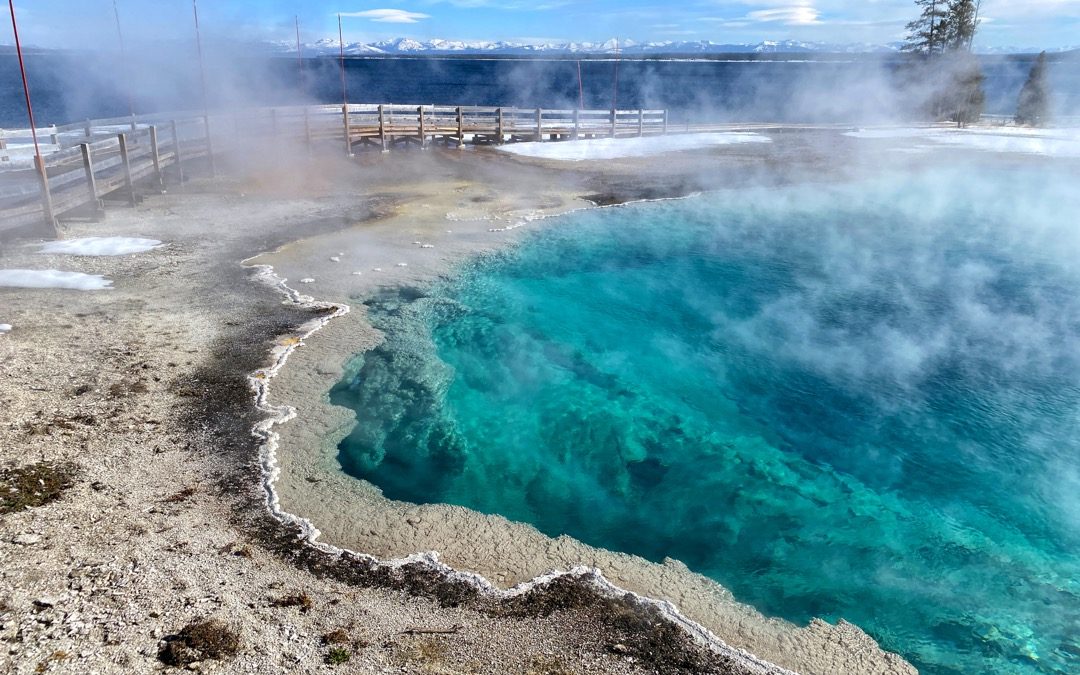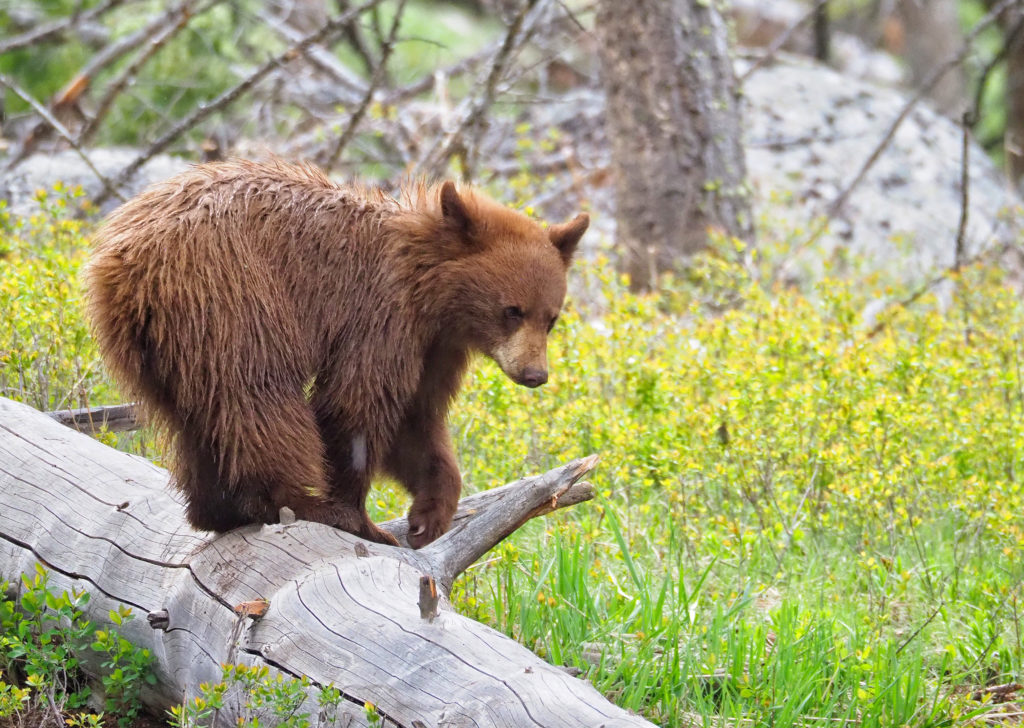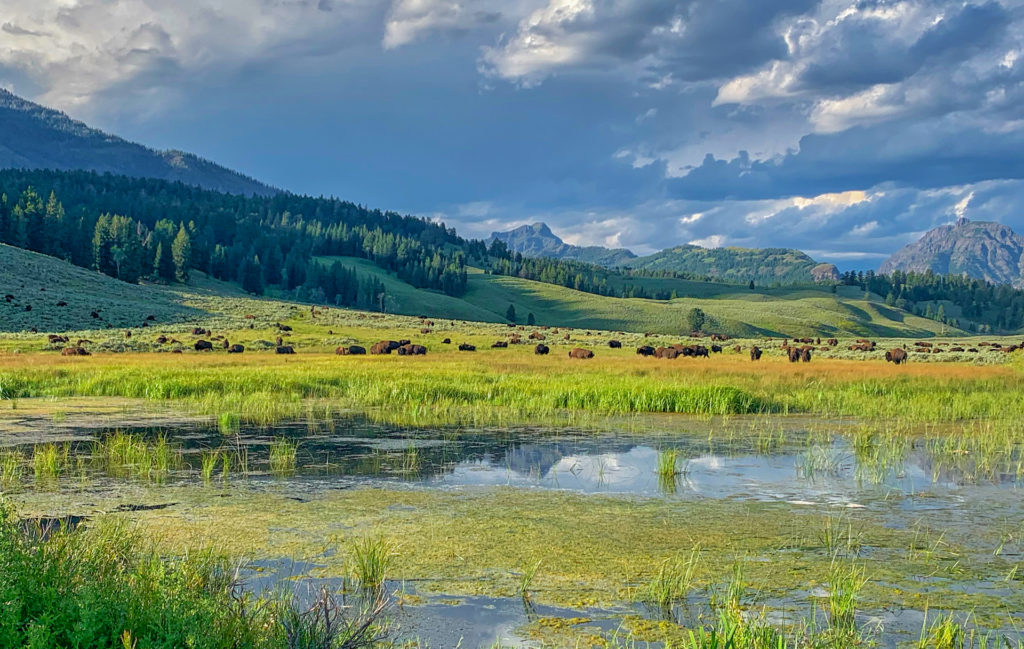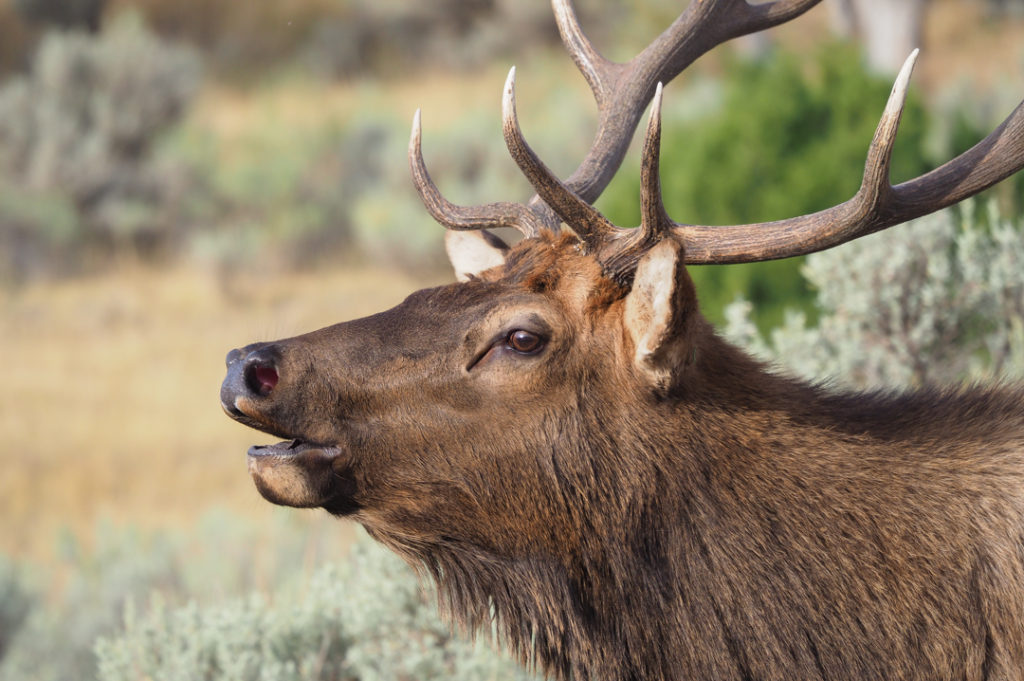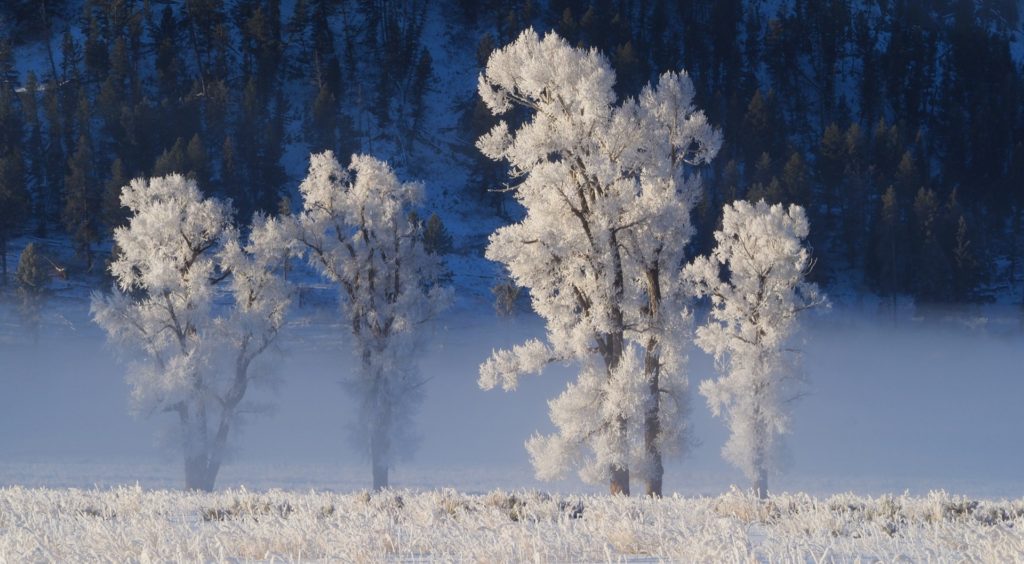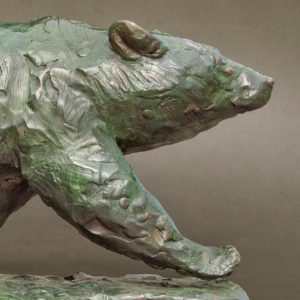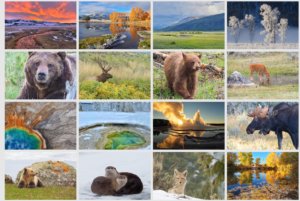When is the best time to visit Yellowstone?
It depends on what you’re interested in. Every season offers its own wonder, if you know where to go, when to slow down, and how to find Yellowstone’s magic amidst summer’s crowds (it can be done!) or winter’s beautifully frigid temperatures. Look no further for your complete guide to when to visit Yellowstone for the best wildlife, wildflowers, hiking, or scenery, including insider tips for each season.
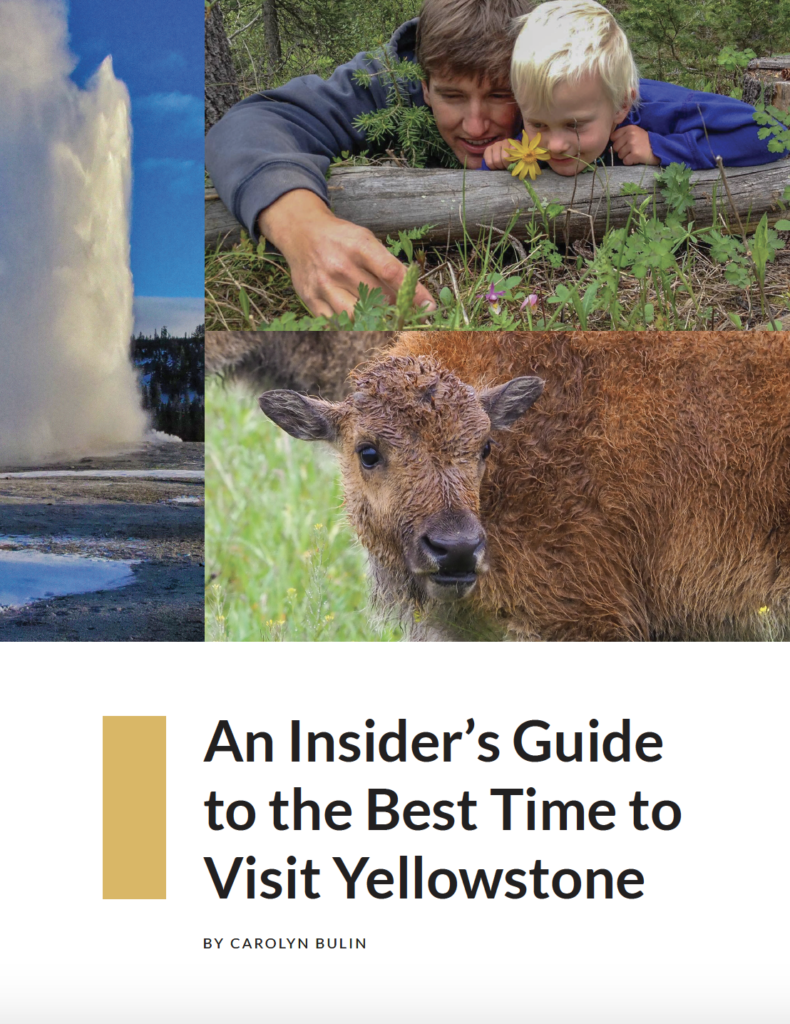
Spring in Yellowstone (April – mid-June)
Splashes of color dot the landscape as the first wildflowers erupt in the wake of receding snow. Baby animals frolic in green valleys. Rivers swollen with snowmelt roar with the power of this wild place.
Best for: Wildflowers, diversity of wildlife (including bears and baby animals), fewer crowds (especially in early spring).
Where to stay: Gardiner, Montana/Mammoth Hot Springs and Cooke City/Silver Gate are the best base camps for wildlife watching in Lamar Valley and are the only options in early spring before most park roads open for the season. Later in the season, Canyon Village and Lake Village offer good access to Hayden Valley for some wildlife watching and also allow easier day trips to the geyser basins on the west side of the park.
Special considerations: Check scheduled spring opening dates for roads, lodging, and other facilities before you plan your trip; roads and facilities in the park interior do not begin opening until mid April. Plan hikes carefully to account for lingering high-elevation snows, seasonal wildlife closures, and rivers that may be too high and swift to ford safely. Be prepared for a wide range of weather conditions, from below freezing to above 70 degrees Fahrenheit.
Insider tips: Spring in Yellowstone begins when the first buttercups bloom under melting snow. Migrant birds begin to return, and soon the landscape erupts with purple larkspur, pink shooting stars, and white spring beauty. Bold arrowleaf balsamroot and sticky geranium blanket the hillsides with yellow and pink. In contrast, calypso orchids hide beneath underbrush in damp forest pockets (“calypso” comes from Greek mythology and means “hidden”); look for them in the forests near Mammoth Hot Springs and Blacktail Plateau.
Spring is one of the best times to see a variety of wildlife in Yellowstone. Lingering snow in the high country concentrates many species in the green valley bottoms – and coincidentally along the park’s road corridors – making for easier viewing. Bison calves, pronghorn fawns, and elk calves dot the landscape, and with some persistence, skill, and luck, you may enjoy sightings of wolf pups or bear cubs.
Bison calves–often called red dogs for their rusty coats–are the first wild babies to appear each spring, usually by mid-April; look for them in Lamar Valley, along the road from Lamar to Mammoth Hot Springs, and in meadows among the geyser basins on the west side of the park.
Elk calves are often visible near the North Entrance in Gardiner, Montana; in Mammoth Hot Springs village; and in the Lamar Valley area. Bears and wolves can be more elusive. Bears’ spring diets often focus on nutrient-rich spring vegetation, so look for black bears munching grass in the forests and meadows between Mammoth and the Lamar Valley and grizzly bears devouring spring beauties and other greens on the slopes above Lamar.
Wolves’ lives revolve around caring for pups in the spring. Wolf pups are usually born in April or early May, and they emerge from their dens for the first time at about three weeks old. Occasionally well-known wolf dens can be viewed safely and ethically from the road corridor. Otherwise, tune in to your surroundings (such as the behavior of elk and other possible prey species, and the warnings of coyotes or birds) to search for adult wolves on the move.
Speaking of tuning in, don’t forget to take some time to slow down, sit, and observe the smaller critters that abound in springtime in Yellowstone: sit near a pond and watch the frenzy of bird activity, lounge in the sagebrush to observe the lively Uinta ground squirrels (maybe they’ll tell you that a badger or a coyote is near!), or sketch one of the many spring wildflowers.
Summer in Yellowstone (Mid-June – August)
Summer is fleeting in Yellowstone, but gorgeous while it lasts. Warmer temperatures, afternoon thunderstorms, the bison rut (mating season), and glorious hiking epitomize summer in Wonderland.
Best for: Hiking, bison rut, warmer and more predictable weather, diversity of experiences and facilities available.
Where to stay: With all in-park and gateway facilities open, there are a lot of options. Consider which part of the park you’d like to focus your time, and then book your lodging or campgrounds accordingly to avoid long drives on summer’s busy roads.
Special considerations: Summer is the busiest season in Yellowstone, so be sure to check out our tips for how to avoid the crowds; expect traffic delays on busy roads, and plan extra time to reach your destination. It’s also mosquito and biting fly season, so be prepared with insect protection such as lightweight long sleeves and long pants and bug spray. While the weather is generally more predictable in summer than in spring or fall, afternoon thunderstorms are common and can brew quickly.
Insider tips: The first blooms of lupine and paintbrush usher in summer in Yellowstone. As wild rose blossoms fade, high-elevation snow fields retreat and rivers ebb. This is the perfect time to hit the trails: by mid-summer, most rivers are passable and most trails are snow-free and dry. Start your hikes early to avoid crowds and increase your chances of seeing wildlife, and plan to be off exposed ridges and peaks by early- to mid-afternoon when thunderstorms are likely to roll in. Even though the weather is often cooperative, it can change quickly and we can experience cool temperatures and even snow storms any month of the year, so don’t forget to pack your jacket even for summer hikes.
Thunder isn’t the only thing rumbling across the summer landscape. Deep bellows of bull bison reverberate through Yellowstone’s valleys as the bison rut (or mating season) begins in mid-summer. Yellowstone’s heavyweight champions, 2,000-pound bull bison challenge each other and strive to impress the cow bison by bellowing, wallowing in the dust (and in their own urine), and posturing. Watch and listen to the action from a safe distance in Lamar Valley or Hayden Valley.
When showing off isn’t enough to resolve disputes between evenly matched bull bison, an intense battle may ensue, sometimes with deadly consequences. Casualties of the bison rut are a hotly contested buffet for Yellowstone’s carnivores. Search the valleys for wolves, grizzly bears, and other fauna scavenging on–and sometimes battling over–the prize. If you choose to hike in these areas during the rut, give ornery bulls a wide berth and be on high alert for bison carcasses and the carnivores they attract.
Autumn in Yellowstone (September)
Bluebird days, golden foliage, bugling elk, and world-class fly fishing make autumn a coveted time to visit Yellowstone. Bison bellows are replaced by elk bugles, and summer’s warmth gives way to cooler temperatures and snow.
Best for: Hiking, elk rut, scenery (fall colors and snow-capped peaks), fly fishing.
Where to stay: In-park lodging and campgrounds begin to close in September, so check facility closing dates carefully.
Special considerations: Unpredictable weather can lead to snow-related road closures, particularly on the park’s high-elevation roads (Dunraven Pass between Tower Junction and Canyon Village, Craig Pass between Old Faithful and West Thumb, and Sylvan Pass along the East Entrance Road). Take this into account when planning your itinerary and making lodging or camping reservations, and pack various clothing layers to be comfortable in any weather conditions.
Insider tips: Summer ends as quickly as it began. Animals prepare for winter as fireweed sends cottony seeds floating across the landscape, harbingers of the snowflakes that are soon to come.
As mountain bluebirds and other migrants stage for their journey south, bears enter hyperphagia, which literally means “over-eating”–an accurate term as they consume as many as 20,000 calories per day in preparation for hibernation. To find bears, look for calorie-rich food sources: whitebark pine nuts, army cutworm moths, and elk and bison carcasses are particularly important sources of fat and protein.
Smaller species are also storing calories to prepare for winter. The diminutive pika, a member of the rabbit family, is busy building “haystacks” to cure vegetation for winter consumption. Pikas are sensitive to warm temperatures, so look for them in talus slopes at high elevations (such as Mount Washburn) or among large boulders that trap cool air even in the warmest summer months (such as the Hoodoos south of Mammoth Hot Springs). Listen carefully: their one-note call may give away their presence before you see them.
Autumn hiking can be heavenly: warm days with cobalt skies can lure even the most relaxed visitors onto the trails. Slow down to enjoy Yellowstone’s subtle version of fall colors; aspens and cottonwoods lend welcome pops of gold to a color pallet dominated by grasses, willows, and other shrubs. Even inclement weather provides its own beauty, so come prepared for all weather conditions to make the most of your autumn visit.
Don’t expect to avoid the crowds simply by coming in September. Post-Labor Day visitation has rivaled July and August visitation for several years now, and September can seem just as hectic as the summer months.
Winter in Yellowstone (December – March)
A blanket of snow transforms Yellowstone into a true Wonderland. With fewer visitors, it’s easier to find silence and solitude to contemplate the magic, and a white backdrop makes spotting wildlife almost easy.
Best for: Wolf watching (especially during mating season in February), cross-country skiing, snowshoeing, silence and solitude, scenery, fanciful snow and ice formations in the geyser basins.
Where to stay: For wildlife watching, choose Gardiner, Montana/Mammoth Hot Springs and Cooke City/Silver Gate. For easier access to the geyser basins, consider Gardiner/Mammoth or West Yellowstone and book a day tour by snowcoach to the Interior; or book rooms at the Old Faithful Snow Lodge.
Special Considerations: The only road open to wheeled vehicles in the winter months is the northern road from Gardiner through Mammoth Hot Springs and to the Northeast Entrance. For scheduled road opening and closing dates, as well as up-to-date information on park road conditions, visit the Yellowstone National Park website. To visit the Interior (including the geyser basins and Grand Canyon of the Yellowstone), you’ll need to book over-snow (snowmobile or snowcoach) transportation, which often sells out so it’s important to plan ahead. The Old Faithful Snow Lodge and Mammoth Hot Springs Hotel are the only in-park lodging facilities open in the winter; both fill quickly, so plan ahead with early reservations.
Insider tips: The white landscape may appear lifeless, but perhaps the most amazing part about winter in Yellowstone is that the biotic community is very much alive beneath the blanket of snow. Even the snowpack itself is dynamic, constantly changing with variations in air temperature, fluctuations in humidity, and the weight of time.
Frigid air temperatures give rise to a phenomenon called depth hoar, whereby sugary hoarfrost crystals form at the base of the snowpack, creating an airy layer of snow that winter-active rodents such as voles move through easily. While you’re not likely to see the voles themselves, be sure to look for foxes, their red coats standing out against the white snow as they perform their acrobatic, nose-first dives into the snow in pursuit of voles.
Foxes’ larger cousins, wolves, are also easier to spot in the winter months than other times of year. During their breeding season in mid-winter, wolves are often vocal and on the move, hunting for prey, defending their territories, and searching for breeding opportunities or vacant territories in which to establish new packs. Search for them across the Northern Range from Mammoth Hot Springs to Lamar Valley.
Whether you plan to visit the geyser basins, search for wildlife, or enjoy more active pursuits such as cross-country skiing or snowshoeing, dressing in layered clothing is the key to a comfortable and enjoyable winter experience in Yellowstone. Temperatures can range from below -20 to above freezing.
In many ways, the coldest days are the most beautiful. When the temperature plummets below zero, you’ll want to be comfortable enough to enjoy the wonder of moisture freezing as it floats through the air to create aptly-named diamond dust, steam from geysers and hot springs freezing on contact with cold surfaces to coat trees with fanciful layers of ice that look like all manner of real and imaginary creatures, and hoarfrost adorning every tree, shrub, and exposed blade of grass.
For more information about how to prepare (and pack for) each season, see our Yellowstone Packing Lists for Every Season.
Need help planning your trip? Book a Yellowstone Trip Planning session with our favorite guide partners.
Carolyn Bulin has been sharing her passion for the Greater Yellowstone Ecosystem for over a decade. As a naturalist and certified trainer of interpretive guides, she enjoys leading field classes and teaching others the art and science of guiding. When not teaching or writing, she can be found exploring the park with her husband and daughter.
Photos © Jenny Golding

